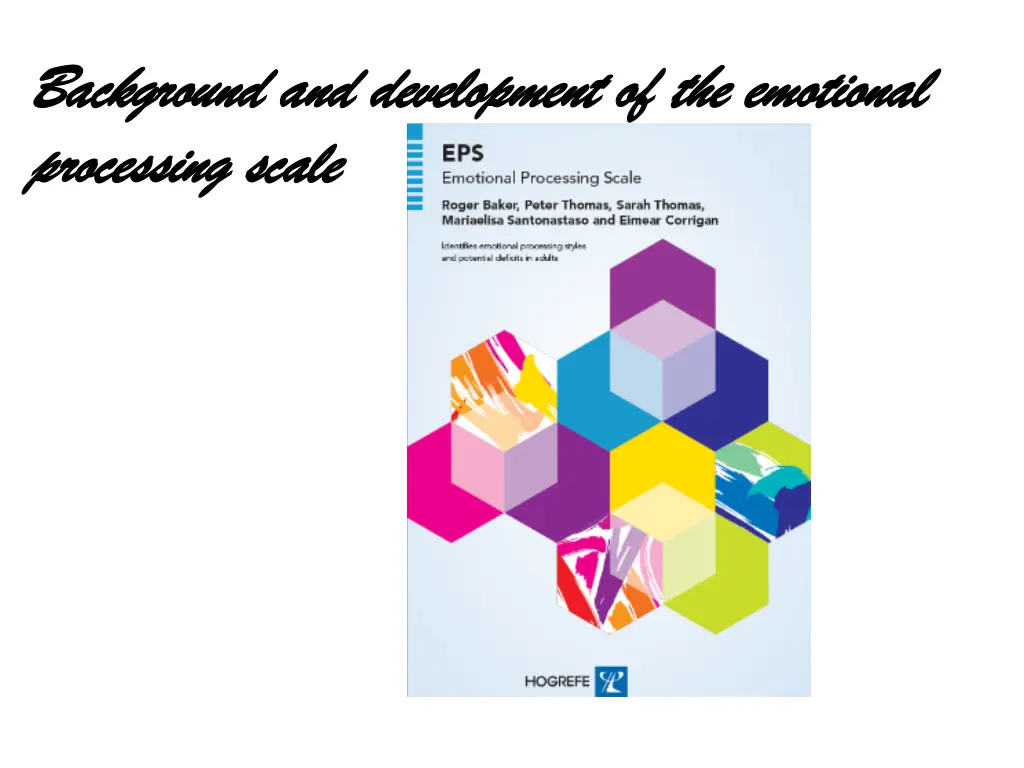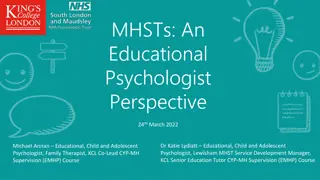
Understanding Emotional Processing Scale Development
Explore the background and development of the Emotional Processing Scale, a tool based on emotion theories, therapy approaches, and clinical experiences. Discover how emotional control and processing impact conditions like panic disorder. References by Baker provide insights into overcoming fear and healing through emotional processing.
Download Presentation

Please find below an Image/Link to download the presentation.
The content on the website is provided AS IS for your information and personal use only. It may not be sold, licensed, or shared on other websites without obtaining consent from the author. If you encounter any issues during the download, it is possible that the publisher has removed the file from their server.
You are allowed to download the files provided on this website for personal or commercial use, subject to the condition that they are used lawfully. All files are the property of their respective owners.
The content on the website is provided AS IS for your information and personal use only. It may not be sold, licensed, or shared on other websites without obtaining consent from the author.
E N D
Presentation Transcript
Background and development of the emotional Background and development of the emotional processing scale processing scale
The original items for the scale were based on a conceptual model developed over many years, clinical and research interviews, case histories, personal experiences, autobiographies and the emotion literature. It was informed by major emotion theories, cognitive theories and experiential theories, by behaviour therapy, cognitive therapy, experiential therapy, psychotherapy, and the fields of psychosomatics, medicine and neuropsychology.
Control of three emotions: Anger, Sadness and Anxiety Courtauld Emotional Control Scores adjusted for age and gender 28 Strong control Level of Control Control 21 Anger Sadness Anxiety Slight control 14 Disorder Panic Group Scottish Healthy Controls n = 118 English Healthy Controls n = 48 n = 387
Other Emotional Processing Dimensions (expressed as means and standard deviation Panic Disorder Group 3.6 (0.6) Scottish Healthy Controls 3.1 (0.7) t P Value 3.5 .001 Awareness of feelings 2.2 (0.9) 1.7 (0.8) 3 .01 Able to label emotions 18 (4.3) 13.6 (4.3) 4.5 .0000 Controlling the experience of emotion 45 (5.0) 39.6 (9.4) 3.1 .01 Control the expression of emotion
Emotional processing and panic Reference: Baker R., Holloway J., Thomas P.W., Thomas S., Owens M. (2004) Emotional Processing and Panic. Behaviour Research & Therapy. 42,1271-1207
Reference: Baker, R. (2004). Understanding Panic Attacks and Overcoming Fear. Oxford: Lion-Hudson
Reference: Baker, R. (2007) Emotional Processing: Healing through Feeling. Oxford, Lion-Hudson
Initial item selection Schematic model Clinical experience Literature Case histories 300 draft items/ideas 152-items 101-items
Development of Emotional Processing Scale Version 1 Given to 60 healthy people Analysis of data 101 53 patients visiting the doctor questions 37 mental health patients n = 150
Development of Emotional Processing Scale Version 2 Given to 100 students Analysis of data 45 questions 73 older healthy people 124 cancer patients 16 back pain patients 147 mental health patients n = 460
Development of Emotional Processing Scale Version 3 Given to 310 healthy people Analysis of data 53 questions 86 patients visiting the doctor 114 pain patients 180 mental health patients n = 690
Development of Emotional Processing Scale FINAL VERSION 25 QUESTIONS
How the questionnaire is rated 1. I smothered my feelings. 0 1 2 3 4 5 6 7 8 9 completely---------------------- disagree--------------------------in between ------------------------- agree------------------------ completely disagree agree 2. Unwanted feelings kept intruding. 0 1 2 3 4 5 6 7 8 9 completely----------------------- disagree-------------------------in between ------------------------- agree------------------------ completely disagree agree 3. When upset or angry it was difficult to control what I said. 0 1 2 3 4 5 6 7 8 9 completely----------------------- disagree-------------------------in between ------------------------- agree------------------------ completely disagree agree
There are three articles on the Development of the scale: References: Baker, R., Thomas, S., Thomas, P.W., Owens, M. (2007) Development of an Emotional Processing Scale. Journal of Psychosomatic Research, 62: 167- 178 Baker R, Thomas S, Thomas P, Gower R, Santonastaso M, Whittlesea A. (2009) The Emotional Processing Scale: Scale refinement and abridgement (EPS- 25) Journal of Psychosomatic Research 68, 1, 83-88 Baker R, Owens M, Thomas S, Whittlesea A, Abbey G, Gower P, Tosunlar L, Corrigan E, Thomas PW: Does CBT facilitate emotional processing? Behav Cogn Psychother; 2012 Jan;40(1):19-37






















